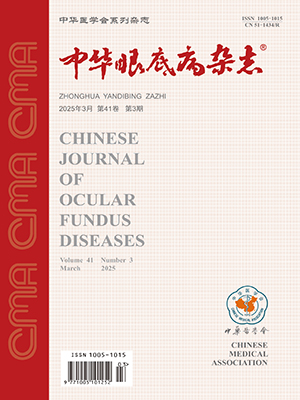| 1. |
Parisi V, Ziccardi L, Sadun F, et al. Functional changes of retinal ganglion cells and visual pathways in patients with chronic Leber’s hereditary optic neuropathy during one year of follow-up[J]. Ophthalmology, 2019, 126(7): 1033-1044. DOI: 10.1016/j.ophtha.2019.02.018.
|
| 2. |
Yen MY, Wang AG, Wei YH. Leber's hereditary optic neuropathy: a multifactorial disease[J]. Prog Retin Eye Res, 2006, 25(4): 381-396. DOI: 10.1016/j.preteyeres.2006.05.002.
|
| 3. |
Majander A, Robson AG, João C, et al. The pattern of retinal ganglion cell dysfunction in Leber hereditary optic neuropathy[J]. Mitochondrion, 2017, 36: 138-149. DOI: 10.1016/j.mito.2017.07.006.
|
| 4. |
Yu-Wai-Man P, Griffiths PG, Chinnery PF. Mitochondrial optic neuropathies-disease mechanisms and therapeutic strategies[J]. Prog Retin Eye Res, 2011, 30(2): 81-114. DOI: 10.1016/j.preteyeres.2010.11.002.
|
| 5. |
韦企平, 孙艳红, 宫晓红, 等. 中国人Leber遗传性视神经病变线粒体DNA突变的主要类型和临床特征[J]. 中华眼底病杂志, 2004, 20(2): 78-80.Wei QP, Sun YH, Gong XH, et al. The major types and clinical manifestations of mitochondrial DNA mutations in Chinese patients with Leber′s hereditary optic neuropathy[J]. Chin J Ocul Fundus Dis, 2004, 20(2): 78-80.
|
| 6. |
Yang S, Ma SQ, Wan X, et al. Long-term outcomes of gene therapy for the treatment of Leber's hereditary optic neuropathy[J]. EBioMedicine, 2016, 10: 258-268. DOI: 10.1016/j.ebiom.2016.07.002.
|
| 7. |
Wan X, Pei H, Zhao MJ, et al. Efficacy and safety of rAAV2-ND4 treatment for Leber’s hereditary optic neuropathy[J/OL]. Sci Rep, 2016, 6(1): 21587[2016-02-19]. http://europepmc.org/article/MED/26892229. DOI: 10.1038/srep21587.
|
| 8. |
Zhang Y, Li X, Yuan JJ, et al. Prognostic factors for visual acuity in patients with Leber’s hereditary optic neuropathy after rAAV2‐ND4 gene therapy[J]. Clin Exp Ophthalmol, 2019, 47(6): 774-778. DOI: 10.1111/ceo.13515.
|
| 9. |
国际临床视觉电生理学会. 视觉电生理诊断流程指南[J]. 中华眼科杂志, 2020, 56(7): 492-508. DOI: 10.3760/cma.j.cn112142-20200217-00077.International Society for Clinical Visual Electrophysiology. Guidelines for the diagnostic process of visual electrophysiology[J]. Chin J Ophthalmol, 2020, 56(7): 492-508. DOI: 10.3760/cma.j.cn112142-20200217-00077.
|
| 10. |
Yang S, Yang H, Ma SQ, et al. Evaluation of Leberʼs hereditary optic neuropathy patients prior to a gene therapy clinical trial[J]. Medicine, 2016, 95(40): 1-6. DOI: 10.1097/MD.0000000000005110.
|
| 11. |
Theodorou-Kanakari A, Karampitianis S, Karageorgou V, et al. Current and emerging treatment modalities for Leber’s hereditary optic neuropathy: a review of the literature[J]. Adv Ther, 2018, 35(10): 1510-1518. DOI: 10.1007/s12325-018-0776-z.
|
| 12. |
陈倩, 田国红. 视觉电生理结果的解读[J]. 中国眼耳鼻喉科杂志, 2018, 18(1): 68-72. DOI: 10.14166/j.issn.1671-2420.2018.08.022.Chen Q, Tian GH. Interpretation of visual electrophysiological results[J]. Chin J Ophthalmol Otorhinolaryngol, 2018, 18(1): 68-72. DOI: 10.14166/j.issn.1671-2420.2018.08.022.
|
| 13. |
Tai TYT. Visual evoked potentials and glaucoma[J]. Asia Pac J Ophthalmol (Phila), 2018, 7(5): 352-355. DOI: 10.22608/APO.2017532.
|
| 14. |
William J, Joyce C, Janet L. Gene therapy for Leber hereditary optic neuropathy[J]. Ophthalmology, 2016, 123(3): 558-570. DOI: 10.1016/j.ophtha.2015.10.025.
|
| 15. |
Liu HL, Yuan JJ, Zhang Y, et al. Factors associated with rapid improvement in visual acuity in patients with Leber's hereditary optic neuropathy after gene therapy[J]. Acta Ophthalmol, 2020, 98(6): e730-e733. DOI: 10.1111/aos.14379.
|
| 16. |
Zhang Y, Yuan JJ, Liu HL, et al. Three cases of Leber's hereditary optic neuropathy with rapid increase in visual acuity after gene therapy[J]. Curr Gene Ther, 2019, 19(2): 134-138. DOI: 10.2174/1566523219666190618094505.
|
| 17. |
Kousal B, Kolarova H, Meliska M, et al. Peripapillary microcirculation in Leber hereditary optic neuropathy[J]. Acta Ophthalmol, 2019, 97(1): e71-e76. DOI: 10.1111/aos.13817.
|
| 18. |
Balducci N, Cascavilla ML, Ciardella A, et al. Peripapillary vessel density changes in Leber's hereditary optic neuropathy: a new biomarker[J]. Clin Exp Ophthalmol, 2018, 46(9): 1055-1062. DOI: 10.1002/ceo.13326.
|
| 19. |
Wang D, Liu HL, Du YY, et al. Characterisation of thickness changes in the peripapillary retinal nerve fibre layer in patients with Leber’s hereditary optic neuropathy[J/OL]. Br J Ophthalmol, 2020, 2020: E1-6[2020-08-29]. http://bjo.bmj.com/lookup/pmidlookup?view=long&pmid=32862131. DOI: 10.1136/bjophthalmol-2020-316573. [published online ahead of print].
|
| 20. |
Ziccardi L, Parisi V, Giannini D, et al. Multifocal VEP provide electrophysiological evidence of predominant dysfunction of the optic nerve fibers derived from the central retina in Leber’s hereditary optic neuropathy[J]. Graefe's Arch Clin Exp Ophthalmol, 2015, 253(9): 1591-1600. DOI: 10.1007/s00417-015-2979-1.
|
| 21. |
Guy J, Feuer WJ, Davis JL, et al. Gene therapy for Leber hereditary optic neuropathy[J]. Ophthalmology, 2017, 124(11): 1621-1634. DOI: 10.1016/j.ophtha.2017.05.016.
|
| 22. |
Cen LP, Ng TK, Liang JJ, et al. Human periodontal ligament-derived stem cells promote retinal ganglion cell survival and axon regeneration after optic nerve injury[J]. Stem Cells, 2018, 36(6): 844-855. DOI: 10.1002/stem.2812.
|
| 23. |
Pernet V, Joly S, Dalkara D, et al. Long-distance axonal regeneration induced by CNTF gene transfer is impaired by axonal misguidance in the injured adult optic nerve[J]. Neurobiol Dis, 2013, 51: 202-213. DOI: 10.1016/j.nbd.2012.11.011.
|
| 24. |
Yang S, He H, Zhu Y, et al. Chemical and material communication between the optic nerves in rats[J]. Clin Exp Ophthalmol, 2015, 43(8): 742-748. DOI: 10.1111/ceo.12547.
|




